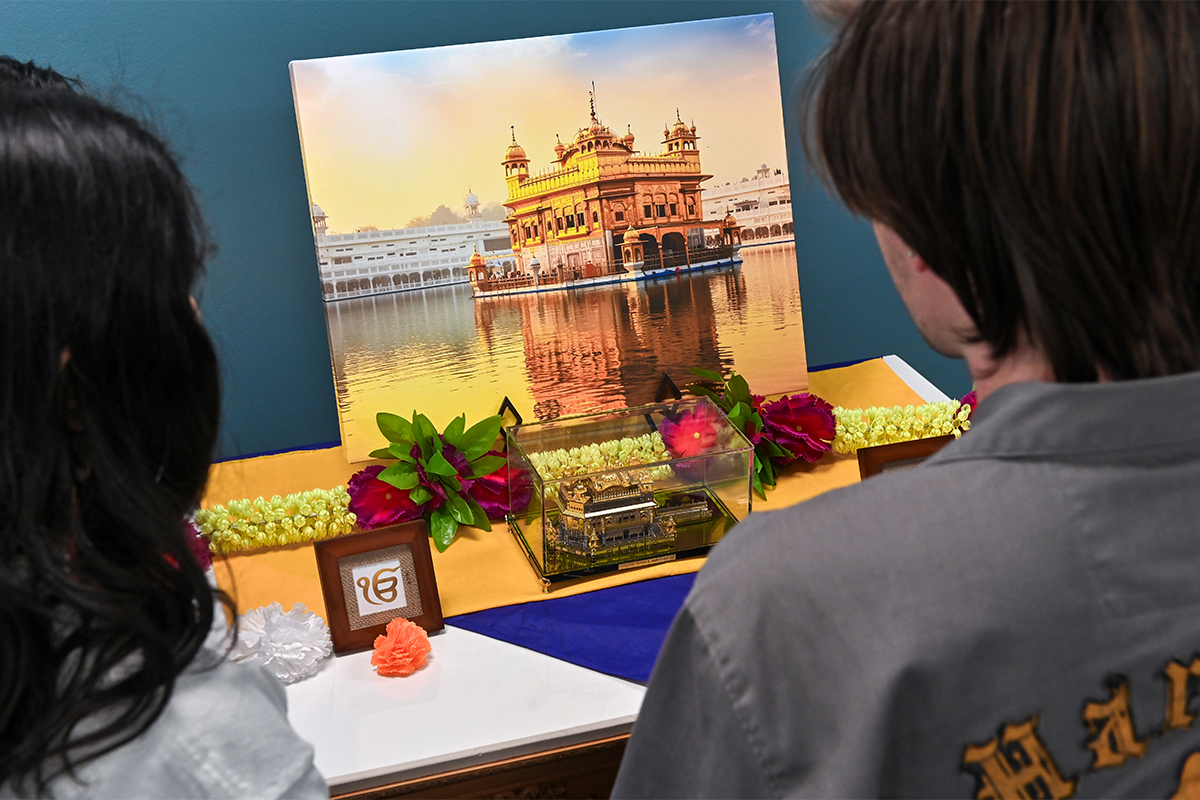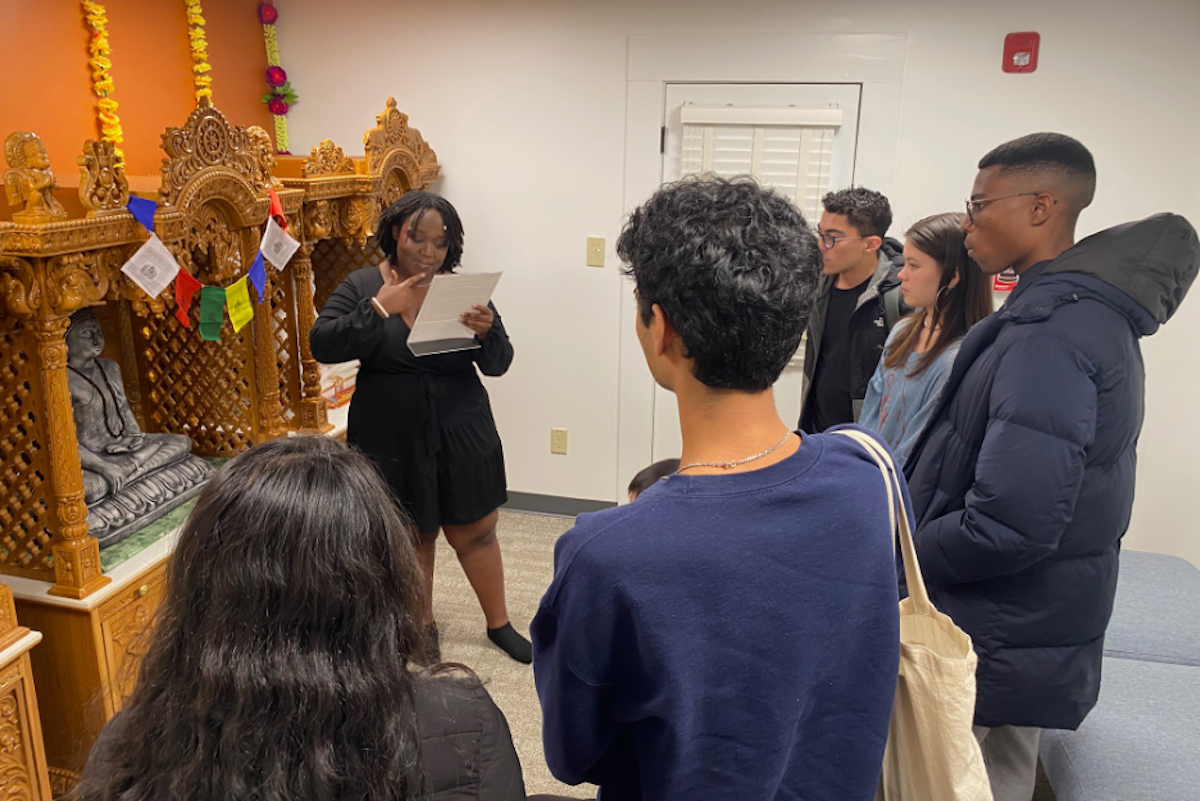Influenced by her religion’s call to reduce harm to all living beings, Shikha Shah came to Emory University in fall 2022 to pursue a master’s degree in public health. Shah practices Jainism, and when she initially saw little representation of her faith at orientation, she thought that following her religious dietary practices, for instance, might be challenging.
“Was there any way that I could get involved in something oriented toward Jain culture, or to try to build a community here?” Shah recalls asking Brahmacharini Shweta Chaitanya, Emory’s Hindu chaplain in the Office of Spiritual and Religious Life (OSRL).
On April 11, three new handmade altars and a cabinet related to four Dharmic religions will be dedicated at the new Emory Interfaith Center, extending a greater welcome for everyone at Emory who practices (or is interested in) Jainism, Sikhism, Hinduism and Buddhism.
The shrines were designed by Emory students, faculty, staff and alumni with the help of the OSRL team. They were then hand-carved in Gujarat, India, and shipped 8,300 miles to Emory.
“We have worked hard to secure these new shrines so that when students arrive here now, they can really feel, ‘I see my tradition, and I have a home here,’” Chaitanya says.
For Jain and Sikh community members, the process of designing the new shrines went even further, coinciding with the founding of official Jain and Sikh student associations at Emory.
“This process led to not just envisioning and commissioning these shrines, but also developing new expressions of community,” Chaitanya says. “‘Who has not been at the table?’ is a very important question to us.”
“This is a milestone of inclusion,” says the Rev. Dr. Gregory W. McGonigle, Emory’s university chaplain and dean of religious life. “With these new sacred items for our community members to use devotionally, and also for all of us to learn from, Emory seeks to express a deep welcome to traditions that have not historically been as visible here — or on many U.S. campuses.”
The new shrines, which are mounted on wheels so they can be used throughout the Interfaith Center, are part of a larger movement at Emory to support the religious and spiritual lives of all students, faculty and staff. Emory has added resources such as new chaplain roles, new programs and new spaces like the Interfaith Center, and everyone at Emory is invited to learn more about the many faiths practiced here.
Jain Altar
Jains revere 24 tirthankaras (enlightened beings) in the present age, ending with Mahavir, who was a contemporary of the Buddha. The new Jain altar in the Interfaith Center includes an image of the tirthankara Rishabhanatha or Adinath Bhagavan.
Rollins School of Public Health student Shikha Shah prays in front of the new Jain altar, donated by Emory faculty and members of the local Atlanta Jain community.
The longtime anchor of Emory’s Jain community is Jagdish N. Sheth, the Charles H. Kellstadt Professor of Business at Goizueta Business School, who was a benefactor to the shrine.
“I am very pleased that the Interfaith Center now includes a shrine for Jainism,” Sheth says. “This is very timely as the number of Jain students is growing at Emory. Equally important is that Jainism is perhaps the most contemporary ancient religion. Its tenets of nonviolence, tolerance of alternative perspectives as well as mindful consumption are directly relevant to contemporary issues of sustainability, community engagement and self-improvement.”
Associate professor of religion Ellen Gough, a Jainism scholar, agrees. “I hear time and time again from students that they see their tradition as distinct from Hinduism, but in this country, Jains have sometimes only found places to practice within Hindu temples,” she says. “The mere existence of this distinct Jain shrine at the Interfaith Center now is hugely important.”
Sikh Cabinet
Like Shah, senior Prabhnoor Kaur was initially surprised to see little representation of her religion at Emory. Sikhism is the fifth-largest religion in the world, with 25 million followers, but she initially saw only a few other Sikhs on campus.

The new Sikh cabinet features images of the Golden Temple, one of the religion’s holiest sites, and includes space to store items used in Sikh worship and devotions.
The Dharmic religions “hold a shared belief of reincarnation, and that as long as you do good in this life, you can ultimately achieve enlightenment,” Kaur notes. “Sikhs are one of the few faiths in this family that don’t revere images, but rather a holy scripture that requires specific rituals at a gurdwara. Our religious cabinet is something that reflects us and respects us, and it’s a physical way of showing that our faith is welcome here.”
Hindu Altar
Hinduism has so many variations “that there isn’t a set worship form or time for everybody,” Chaitanya says. “We wanted to create an open Hindu shrine, that students and employees can access almost any time throughout the week.”
Emory College senior and Student Government Association president Neha Murthy offers devotions at the new Hindu altar with a murti of the Hindu goddess of wisdom.
Having this new shrine at the Interfaith Center will expand support for Emory’s large Hindu community from Cannon Chapel, the Atlanta campus’ main worship center, where the community gathers on Fridays for aarthi and on holidays with a larger congregation.
At the Interfaith Center, students, faculty and staff can visit almost any time throughout the week for their devotions. This new, more accessible Hindu altar provides a space for spiritual exploration as a complement to the classroom, says assistant professor of religion Shiv Subramaniam, an expert on Sanskrit literature, Hinduism and Carnatic music.
“In this country, college is often the first time students think about their connection to religion without the mediation of family,” Subramaniam says. “Whether, when and how to worship — these questions are suddenly yours alone to answer. And while the classroom encourages thinking about religion from all sorts of angles, the critical distance expected there can make personal questions difficult to explore. A space like the Interfaith Center shrine room offers an alternative space where students can do that exploratory work.”
Buddhist Altar
Each of the new shrines presents an educational opportunity, says the Venerable Priya Rakkhit Sraman, Emory’s Buddhist chaplain and a Theravada Buddhist monk.

Emory Buddhist Club members gather in the new Interfaith Center shrine room to discuss the design details of the new Buddhist shrine.
The new Buddhist shrine portrays the Buddha touching the Earth, with the Earth Goddess who witnessed his enlightenment just below. This gesture seeks to connect with Emory’s efforts toward environmental sustainability, and efforts to honor the Muscogee Nation, the Indigenous people of the land where Emory now exists, Sraman says.
“This acknowledgment of the land, history and traditions — we thought this shrine could carry forward that story and connect it back with the Buddha’s relationship with the Earth.
“Together we hope these shrines express how connected everyone is,” he adds. “Over many lifetimes, such stories show that none of us is doing anything completely new. We’ve been honoring what is holy for a long time, in many different ways, over and over again.”
Dedication of Dharmic Altars and CabinetThursday, April 11, at 5:30 p.m. Emory Interfaith Center, 1707 North Decatur Road The celebration will include blessings for the Hindu, Buddhist and Jain altars and the Sikh cabinet. Student reflections, music and a festive meal are part of this event. Register here to attend. |

